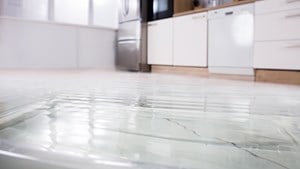How much home insurance do you really need?
7 minute read

When it comes to your home insurance, it’s important that you get the right level of cover so you aren’t left out of pocket if it comes to making a claim. However, it isn’t always easy to get your calculations spot on.

Get Home Insurance
Age Co helps homeowners over 50 find the right protection. We are 100% owned by Age UK and our profits go back to the charity.
Below, you can find some information around how much buildings and contents insurance you should take out to ensure that you don’t lose out.
How much contents insurance do I need?
The amount of contents insurance that you need will depend on how many items you have in your home and how valuable they are. Any items, including furniture, wall art, gadgets, jewellery, clothes and books, should be valued and added together to estimate a basic figure that demonstrates your contents’ worth. Decor items such as curtains, light fittings and flooring should also be included in this calculation. Don’t forget to add up the contents in any outbuildings too, including sheds and garages.
How to estimate home contents value
Trying to calculate the total value of your home’s contents can be tricky and you may not know where to start. Underinsuring your home can be a problem, as can overinsuring your home. If you overestimate how much your possessions are worth, you could be paying too much on your premium, so it’s important to ensure you get as accurate a figure as possible.
Make a list of your items
Before you begin, you'll need something to write notes about the items you own, and their value. You may feel daunted by this task, but breaking it down will make it more manageable. The most logical way to work is by tackling one room at a time.
You can start with whichever room you want, however, it might be best to begin with the main rooms, such as the living room and bedroom. These spaces will likely have the most items that need to be added to your list.
Living room
For the living room, furniture including coffee tables, sofas, armchairs, bookcases and sideboards needs to be added to your list. Next, have a think about any electronics, such as the television, laptops, tablets, DVD players, etc. Home accessories should be counted and don’t forget to include items that are inside units and drawers, like books, CDs and DVDs.
Bedroom
In the bedroom, make a note of furniture items, such as the bed, wardrobes (not built in ones), chest of drawers, ottomans and armchairs. Then, look at your clothing. The easiest way to calculate this is by taking an average of what each piece cost and multiplying this figure by how many items are in your wardrobe.
For example: if you have 50 items in the wardrobe and each one costs an average of £30, the estimated cost of your clothing would be £1,500. You can do a similar thing with any shoes and books too. When it comes to your jewellery, it might be better to individually price everything up, particularly if you have any pieces of value.
Kitchen
In the kitchen, open each drawer or cupboard one at a time and try to apply a price to each item or a group of items. Pans, plates, cutlery, trays and tupperware can be grouped and given an average price, whereas specialty items such as a stand mixer or a casserole dish can be priced separately.
Remember: when it comes to the bathroom and kitchen, permanent fixtures including baths, sinks, cupboards and ovens won’t be added, as they'll come under buildings insurance (see below). The most important items you need to list in these rooms are the cupboard contents and appliances that aren't integral, built-in or fitted.
Other rooms and items to consider
Other rooms that you should value are the dining room, utility room, pantry (the value of the food in the fridge and freezer can be included), additional bedrooms and the attic.
Don’t forget about the garden too. Any objects that you’re likely to take with you if you were to move can be added to your valuation, including garden furniture, plant pots and barbeques.
Once you have a comprehensive list of the majority of the items in your home, you can use your calculator to work out how much contents insurance you need. This may seem like an arduous task, but it could benefit you in the future.
How much buildings insurance do I get?
Buildings insurance can often be more tricky to work out than your contents insurance. Many insurers have different policies that offer various levels of cover depending on the size of your home.
For example: a three-bedroom house wouldn’t usually cost the same to rebuild as a five bedroom house and so the cover could vary. This is also known as bedroom-rated insurance.
Some insurance providers use sum insured cover. Instead of directly calculating the cost to rebuild your home, the provider has a maximum amount that they will pay should your home experience severe damage. The figure should also include the fee to knock down and remove the remains of the old property. You should note that this number will not be the same as your home’s market value before the damage occurred.
Using a surveyor
Because these calculations can be difficult to work out, you may choose to use a chartered surveyor to calculate the sum insured value for you.
You should keep in mind that the cost of rebuilding your home will likely increase over a period of time due to inflation. This is why it may be a good idea to have a survey done every few years. Alternatively, some providers offer index-linked sum insured, which increases the amount your home is insured for in line with inflation, meaning your home won’t be left underinsured.
Some providers will offer an automatic value that will be given to you should your home need to be rebuilt.
Don’t forget that if you undertake any substantial renovations on your home, such as adding an extension, you should alter your buildings insurance to reflect this. You should also alert your insurer about the works beforehand to see if you’ll be covered.
Summary
If you have a home insurance renewal date on the horizon, or you’re looking to protect a new property, keep these key points in mind:
- How much contents insurance you need will depend on the number of items you have and their collective value.
- To avoid under or over insuring your contents, it can be helpful to make a list of everything you own and then work out the cost to replace it all today.
- For buildings insurance, different providers can use different methods for calculating a rebuild, so make sure you go through the policy details before committing to a quote.
- You can use a chartered surveyor to calculate how much building insurance you need, though this will cost money and some insurers will just give an automatic value, regardless of a surveyor’s work.
This has been a quick guide to assessing the value of your home. If you need more information, your provider should be able to help. There may also be guidance in your policy documents to help make sure you have the right protection in place.

Sign up to the Age Co Newsletter
Each month, our email newsletter delivers inspiring stories, practical guides to later life, plus the latest news about Age Co and the charitable work we support.
